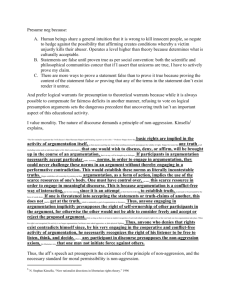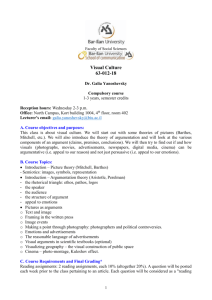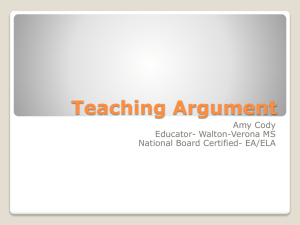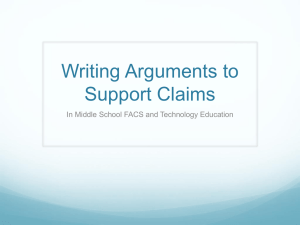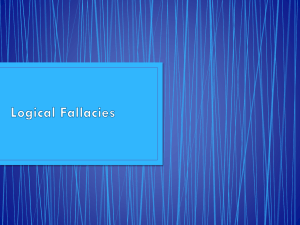*Argument!* Helping students understand what essay writing is about
advertisement
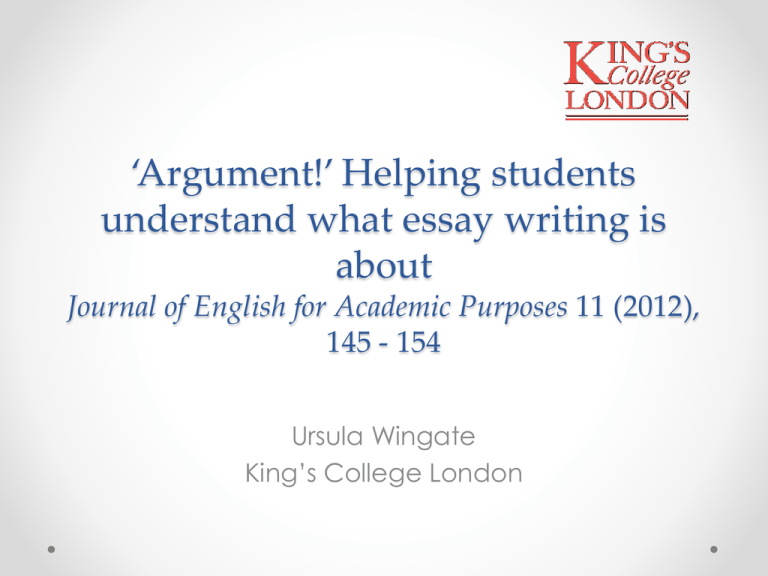
‘Argument!’ Helping students understand what essay writing is about Journal of English for Academic Purposes 11 (2012), 145 - 154 Ursula Wingate King’s College London Concepts of ‘argument’ Single claim: a proposition is supported by grounds and warrants (Toulmin, 1958) Whole text: ‘a process of argumentation, a connected series of statements intended to establish a position and implying response to another (or more than one) position’ (Andrews, 1995, 3). Three components of argumentation 1. The analysis and evaluation of content knowledge 2. The writer’s development of a position 3. The presentation of that position in a coherent manner = Developing an argument Teaching argumentation • Need to teach argumentation within the disciplines (Davies, 2008; Mitchell & Riddle, 2000) • Tutors have fuzzy understanding of argument (e.g. Lea & Street, 1998) • Tutors provide insufficient advice/ unhelpful feedback (‘clarity’, ‘analysis’, ‘argument!’) Learning argumentation Starkly different concepts of argument in secondary school essay Problems with: 1. Analysing and evaluating content knowledge lack of subject knowledge 2. Establishing a position lack of confidence 3. Presenting position in a coherent manner arrangement of propositions into logical structure; not addressed in study guides Research objectives • To identify the concepts of ‘argument’ students have when arriving at university. • To explore the difficulties students experience with argumentation in academic writing. • To discuss the limitations of current instruction and make recommendations for improvements. Methods • Objective 1: Academic Writing Questionnaire to two cohorts (2009 and 2010) with a total of 117 undergraduate students • Objective 2: Analysis of tutor comments on 60 student essays; analysis of 8 student diaries • Objective 3: Analysis of writing guidelines in the Student; analysis of tutor comments on the 60 essays Findings: (1) Students’ concepts of argument Students’ understanding of argument Category (N= 101) 1. Argument requires providing evidence Frequency 48 2. Argument has two sides 39 3. Argument means stating your personal 34 4. 5. 6. 7. 8. opinion Argument means ‘persuasion’ Argument has more than two sides Argument needs a proper conclusion Argument requires analysis Argument involves structure of whole essay 17 15 10 8 7 Example of student answer ‘I believe argument in academic writing is when you strongly believe in a view and state why you believe so’. Findings: (2) Student’s difficulties with argumentation Tutor comments concerning argumentation Low achieving essays (N= 40) No of comments (N = 78) 1. Lack of structure 38 2. Lack of criticality/analysis 14 3. Lack of evidence 12 4. Unrelated conclusion 8 5. Unrelated information 6 % 95 35 30 20 15 Findings: (2) Student’s difficulties with argumentation Themes concerning argumentation in student diaries 1. Use of sources (10 mentions) 2. Writing the Conclusion (7 mentions) 3. Structure ( 6 mentions) 4. Who am I? (6 mentions) 5. Demonstrating knowledge (3 mentions) Analysis through three components of argumentation 1. Analysing and evaluating content knowledge [1] Tutor comments: Cat. 2: Lack of criticality/analysis Cat. 3: Lack of evidence Cat. 5: Unrelated information Example: ‘Your essay lacks criticality. You provide lengthy reports of the literature without discussion.’ Analysing and evaluating content knowledge [2] Students diaries: Theme 1: Use of sources Example: ‘Made tons of notes. I typed all the notes on a word document and totaled 11 pages, which stressed me terribly. I get a feeling that I am going off the topic’. 2. Writers development of a position [1] Examples from tutor comments: ‘You need to try to organise your ideas better, based on authoritative sources but with your own discussion and arguments’ (Cat. 1) ‘Your essay looks like a list of seemingly unrelated points, without progressing towards a meaningful conclusion’ (Cat 4) Writers development of a position [2] Student diaries: Theme 2: Writing the Conclusion Example: ‘I wrote the big section today, so only the conclusion is left. I am not so worried about it, because it’s small’. Theme 4: Who am I? Example: ‘In the exploratory, he accused me of not being critical. How can I criticize xxx [a widely published author]? I know so little, I have to accept what he says’. 3. Presentation of position in coherent manner Tutor comments: Cat. 1: Lack of structure Example: ‘Your arguments tend to get buried in the rather shapeless text structure.’ Student diaries: Theme 3: Structure Example: ‘I have all the information about around 20 theories and approaches, and what I am missing is a structure by which those are to be presented.’ Findings (3): Limitations in teaching argumentation 1. Vague labelling ‘criticality’, ‘analysis’, ‘evaluation’ 2. Argumentation not presented as central requirement of essay writing Extract from writing guidelines: It is very important that you reach your own conclusion based on the evidence you have presented earlier. The main purpose of the conclusion is to reach a final position in your essay. Improving the teaching of argumentation Advice on ‘structure’ Current advice (Student Handbook): ‘The main body will consist of different stages or sub-topics in a logical sequence. It may be organised in different ways. It may, for example, contain a background section and discussion section.’ Advice based on essay writing framework: The structure of the essay should reflect how you developed your position. ….. In the main body, discuss different viewpoints (compare, contrast), and explain why you are taking your position. In the conclusion, briefly summarise the previous discussion and state your position clearly again.


